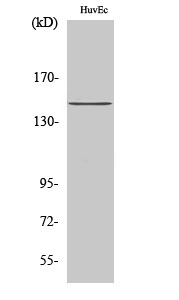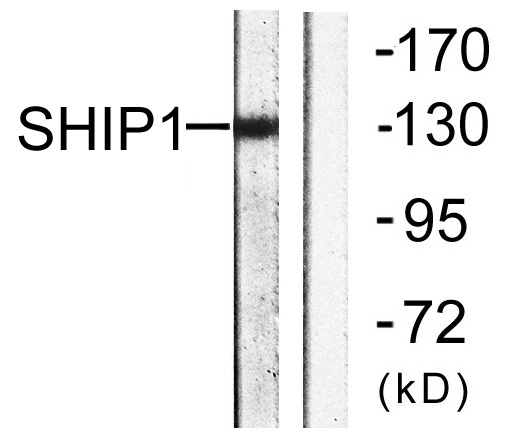Phospho SHIP1 (Y1021) Cell-Based Colorimetric ELISA Kit
- 货号:KA1391C
- 应用:ELISA
- 种属:Human;Mouse;Rat
- 基因名称:
- INPP5D
- Human Gene Id:
- 3635
- Human Swiss Prot No:
- Q92835
- Mouse Swiss Prot No:
- Q9ES52
- Rat Swiss Prot No:
- P97573
- 储存:
- 2-8°C/6 months
- 其他名称:
- Phosphatidylinositol 3,4,5-trisphosphate 5-phosphatase 1 (EC 3.1.3.86) (Inositol polyphosphate-5-phosphatase of 145 kDa) (SIP-145) (SH2 domain-containing inositol 5'-phosphatase 1) (SH2 domain-containing inositol phosphatase 1) (SHIP-1) (p150Ship) (hp51CN)
- 检测方法:
- Colorimetric
- 背景:
- catalytic activity:Phosphatidylinositol 3,4,5-trisphosphate + H(2)O = phosphatidylinositol 3,4-bisphosphate + phosphate.,domain:The NPXY sequence motif found in many tyrosine-phosphorylated proteins is required for the specific binding of the PID domain.,domain:The SH2 domain interacts with tyrosine phosphorylated forms of proteins such as SHC1 or PTPN11/SHP-2. It competes with that of GRB2 for binding to phosphorylated SHC1 to inhibit the Ras pathway. It is also required for tyrosine phosphorylation.,enzyme regulation:Activated upon translocation to the sites of synthesis of PtdIns(3,4,5)P3 in the membrane.,function:Phosphatidylinositol (PtdIns) phosphatase that specifically hydrolyzes the 5-phosphate of phosphatidylinositol-3,4,5-trisphosphate (PtdIns(3,4,5)P3) to produce PtdIns(3,4)P2, thereby negatively regulating the PI3K (phosphoinositide 3-kinase) pathways. Acts as a negative regulator of B-cell antigen receptor signaling. Mediates signaling from the FC-gamma-RIIB receptor (FCGR2B), playing a central role in terminating signal transduction from activating immune/hematopoietic cell receptor systems. Acts as a negative regulator of myeloid cell proliferation/survival and chemotaxis, mast cell degranulation, immune cells homeostasis, integrin alpha-IIb/beta-3 signaling in platelets and JNK signaling in B-cells. Regulates proliferation of osteoclast precursors, macrophage programming, phagocytosis and activation and is required for endotoxin tolerance. Involved in the control of cell-cell junctions, CD32a signaling in neutrophils and modulation of EGF-induced phospholipase C activity. Key regulator of neutrophil migration, by governing the formation of the leading edge and polarization required for chemotaxis. Modulates FCGR3/CD16-mediated cytotoxicity in NK cells. Mediates the activin/TGF-beta-induced apoptosis through its Smad-dependent expression. May also hydrolyze PtdIns(1,3,4,5)P4, and could thus affect the levels of the higher inositol polyphosphates like InsP6.,PTM:Tyrosine phosphorylated by the members of the SRC family after exposure to a diverse array of extracellular stimuli such as cytokines, growth factors, antibodies, chemokines, integrin ligands and hypertonic and oxidative stress. Phosphorylated upon IgG receptor FCGR2B-binding.,similarity:Belongs to the inositol-1,4,5-trisphosphate 5-phosphatase family.,similarity:Contains 1 SH2 domain.,subcellular location:Translocates to the plasma membrane when activated, translocation is probably due to different mechanisms depending on the stimulus and cell type. Partly translocated via its SH2 domain which mediates interaction with tyrosine phosphorylated receptors such as the FC-gamma-RIIB receptor (FCGR2B) or CD16/FCGR3. Tyrosine phosphorylation may also participate to membrane localization.,subunit:Interacts with tyrosine phosphorylated forms of SHC1, DOK1, DOK3, PTPN11/SHP-2, SLAMF1/CD150. Interacts with PTPN11 in response to IL-3. Interacts with receptors EPOR, MS4A2/FCER1B and FCER1G, FCGR2A, FCGR2B and FCGR3. Interacts with GRB2 and PLCG1. Interacts with tyrosine kinases SRC and TEC. Interacts with FCGR2A, leading to regulate gene expression during the phagocytic process. Interacts with c-Met/MET.,tissue specificity:Specifically expressed in immune and hematopoietic cells. Expressed in bone marrow and blood cells. Levels vary considerably within this compartment. Present in at least 74% of immature CD34+ cells, whereas within the more mature population of CD33+ cells, it is present in only 10% of cells. Present in the majority of T-cells, while it is present in a minority of B-cells (at protein level).,
- 功能:
- regulation of cytokine production, adaptive immune response, immune effector process, leukocyte mediated immunity,lymphocyte mediated immunity, adaptive immune response based on somatic recombination of immune receptors built from immunoglobulin superfamily domains, negative regulation of immune system process, positive regulation of immune system process, regulation of leukocyte activation, negative regulation of leukocyte activation, positive regulation of leukocyte activation, regulation of myeloid leukocyte differentiation, negative regulation of myeloid leukocyte differentiation, phosphorus metabolic process, phosphate metabolic process, apoptosis, immune response,intracellular signaling cascade, aging, cell death, negative regulation of cell proliferation, determination of adult life span, negative regulation of biosynthetic process, negative regulation of signal transduction, mult
- 细胞定位:
- Cytoplasm . Cell membrane ; Peripheral membrane protein . Membrane raft . Cytoplasm, cytoskeleton . Membrane ; Peripheral membrane protein . Translocates to the plasma membrane when activated, translocation is probably due to different mechanisms depending on the stimulus and cell type. Translocates from the cytoplasm to membrane ruffles in a FCGR3/CD16-dependent manner. Colocalizes with FC-gamma-RIIB receptor (FCGR2B) or FCGR3/CD16 at membrane ruffles. Tyrosine phosphorylation may also participate in membrane localization. .
- 组织表达:
- Specifically expressed in immune and hematopoietic cells. Expressed in bone marrow and blood cells. Levels vary considerably within this compartment. Present in at least 74% of immature CD34+ cells, whereas within the more mature population of CD33+ cells, it is present in only 10% of cells. Present in the majority of T-cells, while it is present in a minority of B-cells (at protein level).
- June 19-2018
- WESTERN IMMUNOBLOTTING PROTOCOL
- June 19-2018
- IMMUNOHISTOCHEMISTRY-PARAFFIN PROTOCOL
- June 19-2018
- IMMUNOFLUORESCENCE PROTOCOL
- September 08-2020
- FLOW-CYTOMEYRT-PROTOCOL
- May 20-2022
- Cell-Based ELISA│解您多样本WB检测之困扰
- July 13-2018
- CELL-BASED-ELISA-PROTOCOL-FOR-ACETYL-PROTEIN
- July 13-2018
- CELL-BASED-ELISA-PROTOCOL-FOR-PHOSPHO-PROTEIN
- July 13-2018
- Antibody-FAQs


